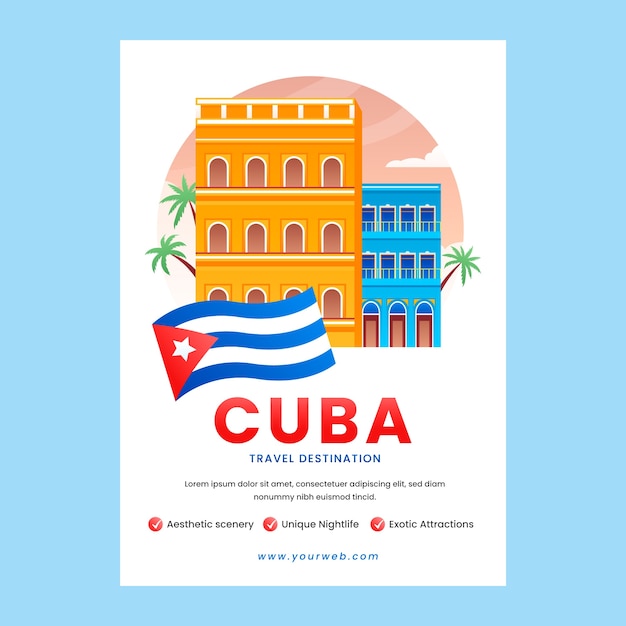Cuban Facts – Exploring the Rich Culture and History of Cuba

Cuba is known for its vibrant music and dance, such as salsa and the cha-cha-cha.
Havana, the capital of Cuba, is famous for its colorful and well-preserved colonial architecture.
Cuba is the largest Caribbean island, spanning over 1,100 kilometers from east to west.
Cuba is home to 9 UNESCO World Heritage Sites, including Old Havana and Trinidad.
The national flower of Cuba is the white mariposa (butterfly jasmine).
Cuba has one of the highest literacy rates in the world, with a strong emphasis on education.
Cuban cigars, particularly Cohiba and Montecristo, are renowned worldwide for their exceptional quality.
The Cuban Revolution led by Fidel Castro in 1959 transformed the country’s political landscape.
Cuba is known for its classic American cars from the 1950s, which are still commonly seen on its streets.
The Cuban cuisine blends African, Spanish, and Caribbean influences, featuring dishes such as moros y cristianos (black beans and rice) and ropa vieja (shredded beef).
Cuba has a rich baseball history and is considered one of the top baseball nations in the world.
The Bay of Pigs invasion in 1961 was a failed attempt by the CIA to overthrow the Cuban government.
Despite being a small island, Cuba has made significant contributions to literature, art, and film.
Cuba has a unique dual currency system, with the Cuban Convertible Peso (CUC) and the Cuban Peso (CUP).
The healthcare system in Cuba is highly regarded and is known for its emphasis on preventive medicine.
Cuban Facts – Exploring the Rich Culture and History of Cuba part 2
Ernest Hemingway lived in Cuba for many years and wrote several of his famous works while residing there.
Cuban rum, such as Havana Club, is internationally recognized and known for its distinct flavor.
Cuba has a tropical climate with warm temperatures year-round, making it a popular tourist destination.
The Malecón, a five-mile-long seawall promenade in Havana, is a popular spot for locals and visitors to enjoy the sunset.
Cuba is famous for its vibrant street art scene, with colorful murals adorning buildings throughout the country.
The Cuban Missile Crisis in 1962 brought the world to the brink of nuclear war during the Cold War.
Coffee is an important part of Cuban culture, with strong, sweetened espresso being a popular choice.
Cuba has a diverse range of ecosystems, including rainforests, wetlands, and coral reefs.
The Tropicana Club in Havana is known for its extravagant outdoor cabaret shows and live performances.
Cuba has a high life expectancy and low infant mortality rate, despite limited resources.
The iconic image of Che Guevara, an Argentine revolutionary who played a key role in the Cuban Revolution, has become a symbol of rebellion worldwide.
Cuban beaches, such as Varadero and Cayo Coco, are famous for their white sand and crystal-clear turquoise waters.
Buena Vista Social Club, a Cuban musical group, gained international fame and helped popularize traditional Cuban music.
Cuba has produced several world-renowned ballet dancers, including Alicia Alonso and Carlos Acosta.
The Cuban flag consists of five alternating blue and white stripes, with a red equilateral triangle on the hoist side and a white five-pointed star in the triangle.
Cuba is known for its lively festivals, such as the Havana Carnival and the Santiago de Cuba Carnival.
The National Capitol Building in Havana, inspired by the U.S. Capitol, is an iconic architectural landmark in Cuba.
Cuba has a strong tradition of Afro-Cuban religion, including Santería, which combines elements of Catholicism and African beliefs.
Cuba has a rich history of producing world-class boxers, such as Teófilo Stevenson and Félix Savón.
Cuban coffee is typically served in small cups and enjoyed alongside lively conversations and socializing.
The Cuban national dish is ropa vieja, which translates to old clothes and consists of shredded beef in a tomato sauce.
Cuba has a strong tradition of rum-making, with many distilleries producing premium aged rums.
The Sierra Maestra mountain range in Cuba is not only beautiful but also played a significant role in the Cuban Revolution.
Cuba is known for its high-quality healthcare, with medical professionals often traveling abroad to provide assistance and conduct research.
The Cuban economy relies heavily on tourism, with millions of visitors coming each year to experience the rich culture and beautiful landscapes.
José Martí, a Cuban poet, journalist, and political activist, is considered a national hero and a key figure in the fight for Cuban independence.
Cuba is famous for its mojitos, a refreshing cocktail made with rum, lime juice, sugar, mint leaves, and soda water.
The Malecón in Havana is a popular gathering place for locals and tourists, providing stunning views of the ocean and city skyline.
Cuba has a strong tradition of dance, including the rumba, mambo, and Afro-Cuban dances like the orisha.
Cuban art, both contemporary and traditional, is highly regarded and has gained international recognition for its unique style and subject matter.

